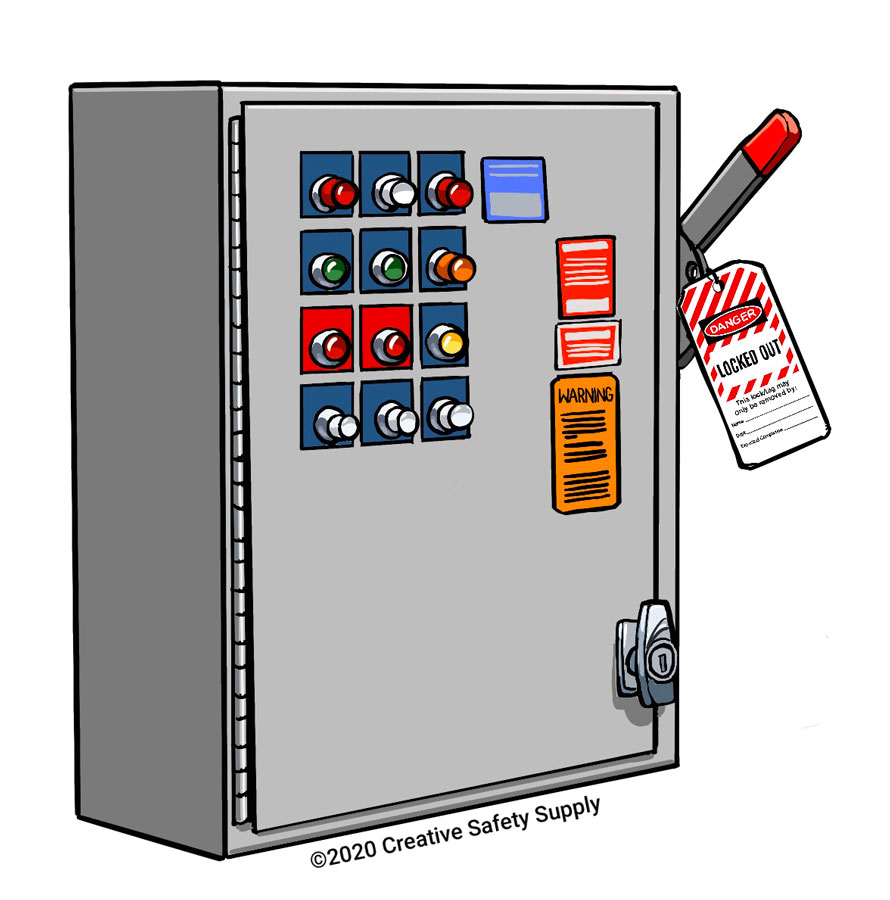
Imagine a service professional performing a routine procedure on a milling machine and an operator turning the machine on without knowing maintenance was taking place. The maintenance employee could get caught in the machine and suffer from a terrible injury or even death. This is exactly why the Occupational Safety and Health Administration requires Lockout/Tagout procedures to control the accidental release of hazardous energy.
Lockout/Tagout (LOTO) procedures should always be used to improve safety in the workplace. However, many facilities have a unique working environment, which can make the decision of whether to use LOTO difficult.

To know when it is necessary to use this essential safety procedure, there is one rule. OSHA regulations have established this in 1910.147(a)(1)(i) by stating the following:
“This standard covers the servicing and maintenance of machines and equipment in which the unexpected energization or startup of the machines or equipment, or release of stored energy, could harm employees.”
What is Lockout Tagout?
The LOTO safety procedure involves the complete de-energization of a machine. In short, maintenance workers have the potential to be exposed to not only electrical hazards while they are performing their daily tasks, but also hazardous energy in the form of mechanical, hydraulic, pneumatic, chemical, nuclear, thermal, or gravitational nature.
Lockout/Tagout procedures will vary from company to company, but when any instances of hazardous energy are present, workers can then go through the following six steps of the basic LOTO procedure:
- Preparation – An authorized employee must identify any sources of hazardous energy.
- Shutdown – Turn off the machine and alert all those who will be affected.
- Isolation – Go to the source of power for the machine and shut it off. This could be a breaker or closing a valve.
- Lockout/Tagout – The employee must attach a tag to the energy-isolating device and physically lock the switch in the off position to prevent others from turning it on.
- Stored Energy Check – Simply turning off the source of energy may not relieve the dangers associated with hazardous energy. The worker must check to see if there is any residual energy left and eliminate it.
- Isolation Verification – It’s always good to double check your work, people’s lives depend on it.
Where to Use LOTO Protocol
The unexpected energization of machines can seriously injure or even kill someone – it's critical that LOTO procedures are closely followed when dealing with hazardous energy. The following are some of the more common situations where LOTO is used.
- Entering areas with moving machine parts – Robotic arms, welding heads that move around to complete tasks, or grinding equipment are all great examples of moving machine parts that pose a dangerous energy source to maintenance crews.
- Fixing machines that are clogged, damaged, or missing parts – If a part becomes damaged within a machine, it may become necessary for someone to reach in to remove it. Putting your hand into a machine that cuts, welds, or crushes objects has some obvious associated dangers.
- Performing electrical work – Those who work at all with electrical components know that LOTO is necessary for their safety. Scheduled repair and inspections, whether it be in the construction industry or anywhere else, requires energy sources to be contained while necessary work is being done.
Employees that adhere to the business’ established Lockout/Tagout training and protocol will dramatically reduce their risk of energy release, and any subsequent injuries.
FAQs
Q: What is the purpose of Lockout/Tagout (LOTO) procedures?
A: The purpose of LOTO procedures is to control the accidental release of hazardous energy that could harm employees. Hazardous energy can be electrical, mechanical, hydraulic, pneumatic, chemical, nuclear, thermal, or gravitational in nature. LOTO procedures involve the complete de-energization of a machine or equipment before servicing or maintenance is performed. LOTO procedures are required by the Occupational Safety and Health Administration (OSHA) in 1910.147(a)(1)(i) for any situation where the unexpected energization or startup of machines or equipment, or release of stored energy, could harm employees.
Q: What are some examples of hazardous energy sources that require LOTO?
A: Some examples of hazardous energy sources that require LOTO are:
- Entering areas with moving machine parts – Robotic arms, welding heads that move around to complete tasks, or grinding equipment are all great examples of moving machine parts that pose a dangerous energy source to maintenance crews.
- Fixing machines that are clogged, damaged, or missing parts – If a part becomes damaged within a machine, it may become necessary for someone to reach in to remove it. Putting your hand into a machine that cuts, welds, or crushes objects has some obvious associated dangers.
- Performing electrical work – Those who work at all with electrical components know that LOTO is necessary for their safety. Scheduled repair and inspections, whether it be in the construction industry or anywhere else, requires energy sources to be contained while necessary work is being done.
Q: What are the benefits of following LOTO protocol?
A: Following LOTO protocol can provide many benefits, such as:
- Improving safety and preventing injuries or fatalities from accidental energization
- Reducing liability and legal risks for employers and employees
- Complying with OSHA standards and regulations
- Enhancing productivity and efficiency by minimizing downtime and errors
- Promoting a culture of safety and awareness in the workplace
Similar Questions
- What is a LOTO procedure?
- What is a Lockout/Tagout (LOTO) program?
- What is the main goal for a LOTO program?
- When should lockout/tagout be used?
- What are machine-specific lockout/tagout procedures?
- What does LOTO stand for?
- What types of hazardous energy can a lockout/tagout program control?
- How does lockout/tagout improve safety?
- Who benefits from LOTO?

